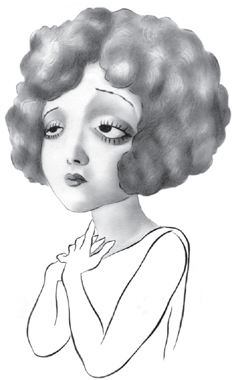

“We did as we pleased. We stayed up late. Today, they’re sensible and end up with better health. But we had more fun.”
Clara Bow was the first celebrity described as the “It Girl” (a phrase from her best-known film, It, 1927). Bow’s unaffected screen persona as a dancing, singing party girl captivated audiences but led to an undeserved off-screen reputation as a tramp from the slums of Brooklyn. She did in fact grow up in poverty, moving to Hollywood in 1923. Studios thought Bow vulgar and actors thought her talentless, but her sincere and uninhibited performances struck a chord with moviegoers. (F. Scott Fitzgerald said she could “stir up every pulse in the nation.”) While her starring roles made tons of money, Bow’s harsh Brooklyn accent didn’t translate well to sound. And she hated learning lines. After a few mildly successful talkies, Bow retired, in 1933.
IT WAS OCCASIONALLY SAID, but mostly understood, yes, Clara Bow was the most famous actress in the world. And yes, she was always incredibly sweet, professional, and beloved by the film crews she worked with. But she was not to be invited to parties. At least the parties of anyone who wished to remain among the respectable Hollywood elite.
This saucy teenager was from (gasp) Brooklyn, her mother was insane, and her father a lecherous hanger-on who was bleeding her dry through a series of failed business ventures. And Bow herself was so licentious that she could shock even jaded old-Hollywood types. As Budd Schulberg, son of Paramount president B. P. Schulberg and later a gifted screenwriter (On the Waterfront) recalled, “They all thought she was a low-life and disgrace to the community.”
But the truth about Bow was simpler. She was a scared twenty-year-old tomboy with little formal education. Her childhood friends were boys, and as a result, the things she enjoyed doing were almost exclusively reserved for men: drinking, gambling, swearing, and screwing. She was also completely sincere.
A fun-loving innocent, at first Bow behaved no worse than a typical twenty-year-old. Sure, she had parties with USC undergraduates, but they only ended in front-yard wrestling matches, like an eleven-year-old on the streets of Brooklyn. Sure, she kept the back door open so cops could stop by and grab a beer. Who wouldn’t?
Her childhood friends were boys, and as a result, the things she enjoyed doing were almost exclusively reserved for men: drinking, gambling, swearing, and screwing.
But Clara Bow had so few friends that she usually played cards with her maid and cook. She ended her multiple affairs with powerful men before they got bored and told her what they really thought. One such powerful man was the elder B. P. Schulberg himself, who—in addition to keeping Bow as a mistress—had her under contract at Paramount.
However much Schulberg enjoyed the pleasure of Clara’s company, he needed her to appear less scandalous. In an effort to clean up her image, he made her hire a female secretary/chaperone. The woman promptly eloped with Bow’s father. In an attempt to see her through a nervous breakdown, he sent her off to Reno. She returned with $100,000 in gambling debts.
Once, in 1928, Schulberg made the mistake of agreeing to host Bow for dinner. The other prominent guest was Judge Ben Lindsey, a close friend of Schulberg’s wife. The judge had recently been kicked off the bench in Denver after championing premarital sex as a way to reduce the exploding divorce rate. That’s right, in 1928 premarital sex was a big no-no in most of the United States. Not in Hollywood though. And Judge Lindsey, hoping to revive his career amidst the more forgiving celebrity culture, came out to interview Clara Bow as part of a Vanity Fair magazine series called “Impossible Interviews.” It’d be perfect—a judge interviewing a law-breaking tramp!
Bow, clearly uncomfortable at the prospect of dinner with her ex-lover and boss, showed up late and tipsy. Her first move was introducing herself to Judge Lindsey with a French kiss, which he pulled away from quickly—probably because his wife was standing next to him. Even so, Clara soon wrangled him into a dance. As the judge awkwardly complied, she deftly unbuttoned his shirt. Then, arriving at his pants, she didn’t hesitate and began to unzip them, too.
Suddenly, the permissive judge became a scared teenager and jumped away, putting his arm around his wife. Ushered out of the room, Bow was taken to task by B. P. Schulberg.
Clara was confused by the judge’s double standard—“If he likes all that modern stuff,” she asked her boss, “how come he’s such an old stick-in-the-mud?”
A BLOCK AWAY FROM the Hollywood Hotel, the Montmartre Café was Hollywood’s first see-and-be-seen nightclub. Catering to the celebrities it fed, it opened in 1923 graced with imported chandeliers and carpets, and Romanesque architecture. (It was actually on the second floor of the building; the first, appropriately, housed a bank.)
Regulars included Mabel Normand, Joan Crawford, Valentino, Gloria Swanson, John Barrymore, and Marion Davies. The maître d’, Bruce Cabot, went on to star in King Kong. There was dancing, even at lunch; women without partners could take their pick from “the Bachelors’ table,” reportedly well stocked with handsome men. The wife of airplane manufacturer Jack Maddux started a tradition called “Flying Luncheons,” in which she’d take her friends to the Montmartre for lunch, and then into an airplane for an hour or two of cards and conversation while circling the city.
Founder Eddie Brandstatter, hit by the stock-market crash and a series of other bad investments, was forced to sell it in 1932. The building has since run through scores of owners with bad ideas, but managed to preserve its onetime glamour. Today it’s part private-party space, part Hollywood nightclub. And the bank below has become a convenience store.